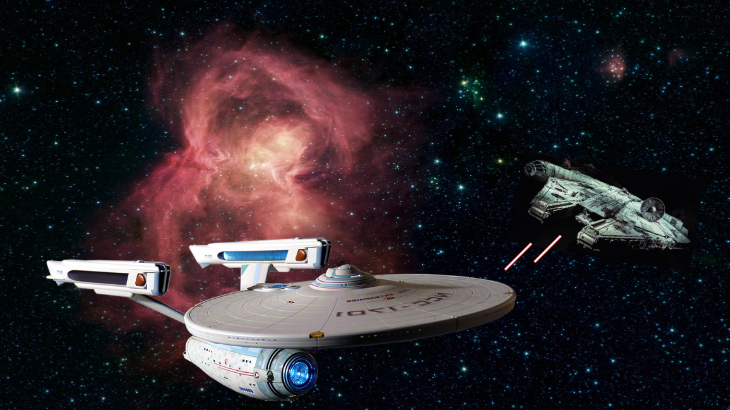The Stars of Sci-Fi: Battle Between “Star Wars” and “Star Trek”
“Star Wars” and “Star Trek” have been battling it out for the top spot in sci-fi for decades, and new content releases are making that competition even fiercer.
March 11, 2020
When one thinks about science fiction, they likely imagine spaceships traversing the universe, discovering new life and fighting space battles with lasers, heavily influenced by books, TV shows and movies. With more and more people leaving books in the dust in favor of binge-watching shows and movies from the comfort of their couch, the iconic “Star Wars” and “Star Trek” universes have become popular standards in the world of sci-fi entertainment. With an abundance of similarities and differences giving each its own flair, it’s time to explore both franchises and see which one is the best fit for each viewer.
Starting with arguably the more popular of the two, “Star Wars” has captivated millions since its first movie, “Episode IV: A New Hope,” was released in 1977. Since then, eight more movies have followed, three prequels and five sequels, to create one linear timeline connecting all of them. Along with these films following one storyline, spin-off movies such as “Rogue One” and “Solo,” and TV adaptations like “The Clone Wars” have helped fill in plot holes between the movies. While known for its flashy battles on land and ship-to-ship combat in space, the franchise has a complex story that’s still growing to this day.
“‘Star Wars’ is very creative and has a very big universe,” senior Marcus Barreto said. “Aside from the original trilogy, it has room to expand on other small stories.”
However, many fans have expressed discontent with the movies released after the original trilogy, specifically the last three released after 2015. Disney’s new sequel trilogy has similarities with the original trilogy, such as a base with planet-destroying weapons and the same villain, Emperor Palpatine.
“They’re trying to leech off of it to try and get as much money as they can,” freshman Alex Mai said. “They’re putting out pointless content, and while some of it is good, some of it isn’t.”
While “Star Wars” has made its name through movies, “Star Trek” has focused on telling its story through multiple TV series, each with several seasons. Since its first episode aired in 1966, “Star Trek” has focused on the exploration of space and its inhabitants. While some fighting occurs, it isn’t as frequent as in “Star Wars” due to a focus on solving problems and mysteries across the stars. Social studies department chair John Downes has been a “Star Trek” fan for a long time, having watched all the series that have been released.
“It’s deeply intellectual; it makes you think,” Downes said. “When you’re watching an episode, they’re usually making social commentary that makes you pause and think about it.”
However, according to Downes, the social commentary started to disappear in later episodes released as the franchise moved to more space fights to compete with popular sci-fi media like “Star Wars,” losing some of its uniqueness in the process.
“It kind of lost a lot of the story and became really violent,” Downes said.
“Star Wars” and “Star Trek” have dominated the sci-fi industry for decades and continue to release new content. With the successful “Mandalorian” series on Disney Plus and other popular characters back for “Star Trek: Picard” on Netflix, the adventure continues for everyone invested in the universes.
“It’s so hard to compete in the world of sci-fi, but ‘Star Trek’ and ‘Star Wars’ are the ones that got it going,” Downes said. “Everything else has kind of been a spin-off of ‘Star Trek’ and ‘Star Wars.’”


